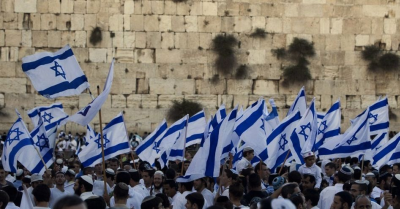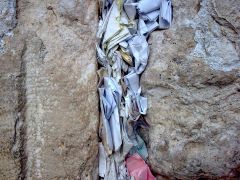Exploring Israel: The Western Wall
By Sean Young, Hebrew Language Blog, Transparent Language
Click here for the original article.

The Western Wall or Ha-Kotel (הַכֹּתֶל הַמַּעֲרָבִי; Arabic:حائط البراق) is a remnant of the ancient wall that surrounded the Jewish Temple’s courtyard, and is the second most sacred site recognized by the Jewish faith (the Temple Mount itself is the most sacred site). הַכֹּתֶל refers not only to the exposed section facing a large plaza in the Jewish Quarter, but also to the sections concealed behind structures running along the whole length in the Muslim Quarter. Just over half the wall dates from the end of the Second Temple period, (beginning about 19 BCE by Herod the Great).
It has been a site for Jewish prayer and pilgrimage for centuries; the earliest source mentioning Jewish attachment to the site dates back to the 4th century. Jews may often be seen sitting for hours at the Wailing-place bent in sorrowful meditation over the history of their race, and repeating often times the words of the Seventy-ninth Psalm.
The earliest clear Jewish use of the term הַכֹּתֶל as referring to the wall visible today was by the 11th-century Ahimaaz ben Paltiel. The name “Wailing Wall”, and descriptions such as “wailing place” appears to be a translation of the Arabic el-Mabka, or “Place of Weeping,” the traditional Arabic term for the wall. This description stemmed from the Jewish practice of coming to the site to mourn and bemoan the destruction of the Temple.
Placing notes in הַכֹּתֶל

There is a well-known practice of placing slips of paper containing written prayers into the crevices of הַכֹּתֶל. More than a million notes are placed each year and the opportunity to e-mail notes is offered by a number of organizations. It has become customary for visiting dignitaries to place notes too.
Sanctity of the Wall
There is much debate about whether it is permitted to place one’s fingers inside the cracks of הַכֹּתֶל to place the prayer notes. Those who warn against such action hold that the breadth of הַכֹּתֶל constitutes part of the Temple Mount itself and therefore retains holiness. Others hold that הַכֹּתֶל stands outside the given measurements of the Temple area and therefore there is no concern about inserting one’s fingers into the crevices. So, you’re going to be hearing from both sides if you choose to insert a prayer.
Men and married women are expected to cover their heads upon approaching הַכֹּתֶל, and to dress appropriately (for women, cover your legs and shoulders – no cleavage showing. Women have been seen to wear plain t-shirts, jeans, slacks, capris, below-the-knee length skirts, short sleeved blouses (with or without a shawl). When departing, the custom is to walk backwards away from הַכֹּתֶל. On Saturdays, it is forbidden to enter the area with electronic devices, including cameras, which infringe on the sanctity of the Sabbath.
Removing your shoes
There was once an old custom of removing one’s shoes upon approaching הַכֹּתֶל. A 17th-century collection of special prayers to be said at holy places mentions that “upon coming to the Western Wall one should remove his shoes, bow and recite…”. Rabbi Moses Reicher wrote “…When within four cubits of the Wall, one should remove their footwear.” Over the years the custom of standing barefoot at הַכֹּתֶל has ceased, as there is no need to remove one’s shoes because the plaza area is outside the sanctified precinct of the Temple Mount.
For Additional Blessings
In the past women could be found sitting at the entrance to הַכֹּתֶל every Sabbath holding fragrant herbs and spices in order to enable worshipers to make additional blessings. In the hot weather they would provide cool water. The women also used to cast lots for the privilege of sweeping and washing the alleyway at the foot of הַכֹּתֶל.

